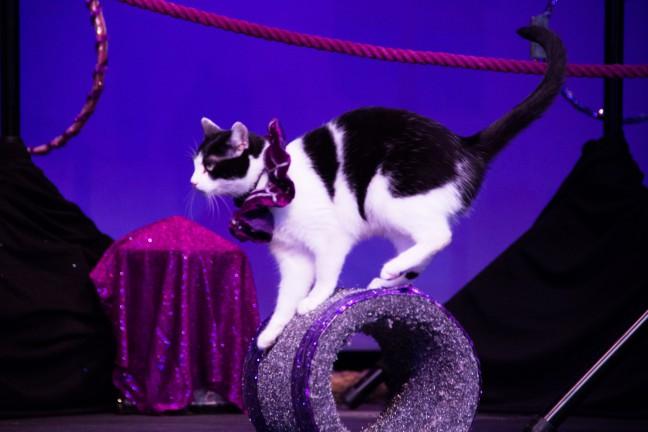“Cat ears! Cat ears, last call!”
A young woman paces the aisles of the Bartell Theater as the house lights dim, peddling costume cat ears from a vendor’s box as though they were Cracker Jacks.
A few rows ahead of me sits an older gentleman with graying hair and stylish glasses, a visibly contented gray cat nesting in his lap.
On stage is a glittering mess of colossal cat toys, scratching posts and pedestals of varying heights plastered in an overwhelming sparkling purple and matte black color scheme. The silence of this setup is interrupted when a plucky chicken pokes his feathered head out of a storage kennel, gazing out on this setup with similar bewilderment to myself.
A small groundhog scuttles onstage from between the curtains and approaches a conveniently groundhog-sized microphone, standing in front of it as a suspiciously human-sounding voice reminds us all to turn off our cell phones.
I’ve come here to see The Amazing Acro-Cats, the best attempt at defeating the idiom “as hard as herding cats” I’ve ever encountered.
Now, it’s worth noting this idiom is justified in its inception. Cats notoriously don’t give a shit about anything, save for things directly related to the procurement or consumption of salmon. Because of their general indifference, the decision to mount a performance foundational on feline performers is a handicap no matter what. It’s like trying to start a basketball team composed entirely of preschoolers, or trying to direct a movie with Vin Diesel in it.

Acro-Cat ringmaster Samantha Martin was well aware of this drawback, and handled it well. Before the show we were warned to remain composed if a cat decided it was tired of performing and decided to wander into the audience, which indeed happened on several occasions throughout the evening. Big tricks were preceded with “now maybe” or “if we’re lucky here,” and performers often required a half-minute of prompting or a mouthful of tuna to complete their feats.
To be fair, some of the stunts these nimble cats completed were legitimately impressive. One cat, who currently holds the Guinness World Record for “longest jump by a cat,” demonstrated her prowess for lengthy leaps. On another occasion, lead cat Tuna faced off in a bowling match against the troupe’s resident chicken, Cluck Norris. These flashy acts were spliced between a routine of more general acrobatics, with cats reluctantly leaping through hoops and climbing about the various structures onstage.

But the most enjoyable aspect of the show was the occasions when the cats refused to perform. Some of these cats have been performing for 10 years with the group, and remain entirely indifferent to putting on a quality performance. The handlers’ faces revealed their mounting frustrations as they repeatedly were reminded the cats simply cannot be bothered to care. Acts lasted only as long as the given cat’s attention could be held by meaty incentives, after which they would succumb to their natural apathy and slink off to sniff a clump of dust or to mingle among the audience’s legs.
In some ways, the difficulty of getting this unruly wad of cats to cooperate made their intermittent successes much more impressive, as the audience is forced to witness how difficult it is to work with these animals. The cats would complete a trick and look around with unenthused bewilderment, evidently unaware they had accomplished anything noteworthy or impressive. The limp showmanship of these felines provided a hilarious contrast to the enthusiasm of the audience and the thinly-disguised impatience of the show’s trainers.

This wonderfully absurd dichotomy of enthusiasm came to a peak at the end of the show, which showcased “The Rock Cats,” a musical act in which the cats played various instruments in catastrophic discord. I couldn’t help but laugh as a half dozen grown adults tried their very hardest to get this horde of cats to play their given instruments, which went terribly. The ensemble choked out intermittent notes at a lumbering tempo, carrying the energy and momentum of a long-neglected diesel locomotive.
This staggering engine of inefficiency churned out a droning melodic procession that perfectly embodied the attitude of the cats towards the concept of performance in general. To the credit of the trainers, they clearly did the best they could. When the performance fell short, it was due to the fickle nature of the four-legged participants.
Attempting to create a consistent and quality production using a feline cast is practically doomed to fail, as cats are generally as willing to cooperate with humans as El Chapo is to cooperate with Mexican law enforcement.
The bottom line is this: If anyone tells you to herd cats, don’t. If someone tells you to herd cats and then make them perform, run for your life.


